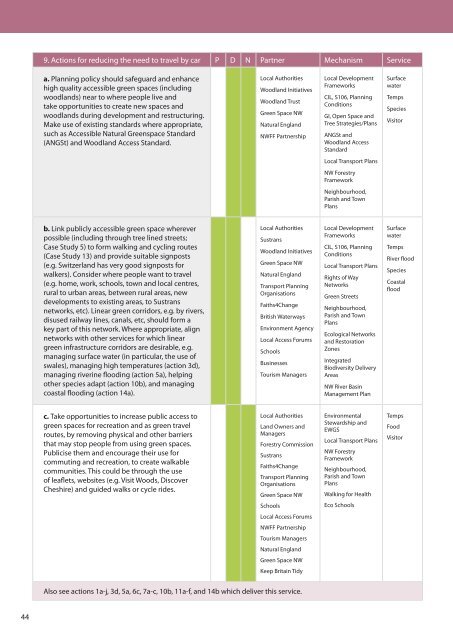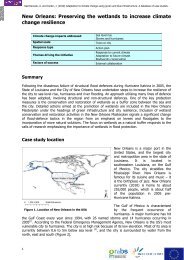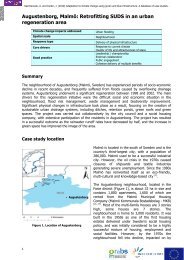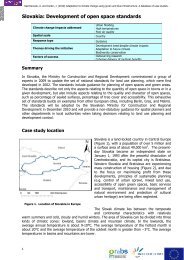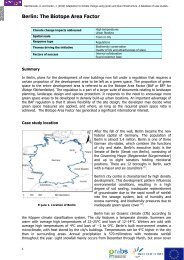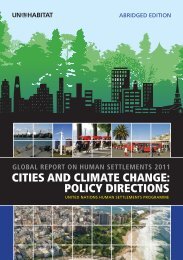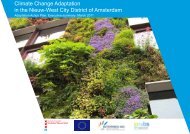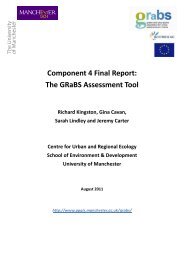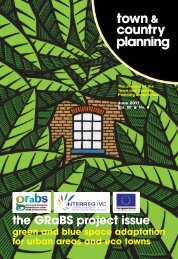Green Infrastructure to Combat Climate Change: A Framework for ...
Green Infrastructure to Combat Climate Change: A Framework for ...
Green Infrastructure to Combat Climate Change: A Framework for ...
You also want an ePaper? Increase the reach of your titles
YUMPU automatically turns print PDFs into web optimized ePapers that Google loves.
9. Actions <strong>for</strong> reducing the need <strong>to</strong> travel by car P D N Partner Mechanism Service<br />
a. Planning policy should safeguard and enhance<br />
high quality accessible green spaces (including<br />
woodlands) near <strong>to</strong> where people live and<br />
take opportunities <strong>to</strong> create new spaces and<br />
woodlands during development and restructuring.<br />
Make use of existing standards where appropriate,<br />
such as Accessible Natural <strong>Green</strong>space Standard<br />
(ANGSt) and Woodland Access Standard.<br />
Local Authorities<br />
Woodland Initiatives<br />
Woodland Trust<br />
<strong>Green</strong> Space NW<br />
Natural England<br />
NWFF Partnership<br />
Local Development<br />
<strong>Framework</strong>s<br />
CIL, S106, Planning<br />
Conditions<br />
GI, Open Space and<br />
Tree Strategies/Plans<br />
ANGSt and<br />
Woodland Access<br />
Standard<br />
Surface<br />
water<br />
Temps<br />
Species<br />
Visi<strong>to</strong>r<br />
Local Transport Plans<br />
NW Forestry<br />
<strong>Framework</strong><br />
Neighbourhood,<br />
Parish and Town<br />
Plans<br />
b. Link publicly accessible green space wherever<br />
possible (including through tree lined streets;<br />
Case Study 5) <strong>to</strong> <strong>for</strong>m walking and cycling routes<br />
(Case Study 13) and provide suitable signposts<br />
(e.g. Switzerland has very good signposts <strong>for</strong><br />
walkers). Consider where people want <strong>to</strong> travel<br />
(e.g. home, work, schools, <strong>to</strong>wn and local centres,<br />
rural <strong>to</strong> urban areas, between rural areas, new<br />
developments <strong>to</strong> existing areas, <strong>to</strong> Sustrans<br />
networks, etc). Linear green corridors, e.g. by rivers,<br />
disused railway lines, canals, etc, should <strong>for</strong>m a<br />
key part of this network. Where appropriate, align<br />
networks with other services <strong>for</strong> which linear<br />
green infrastructure corridors are desirable, e.g.<br />
managing surface water (in particular, the use of<br />
swales), managing high temperatures (action 3d),<br />
managing riverine flooding (action 5a), helping<br />
other species adapt (action 10b), and managing<br />
coastal flooding (action 14a).<br />
Local Authorities<br />
Sustrans<br />
Woodland Initiatives<br />
<strong>Green</strong> Space NW<br />
Natural England<br />
Transport Planning<br />
Organisations<br />
Faiths4<strong>Change</strong><br />
British Waterways<br />
Environment Agency<br />
Local Access Forums<br />
Schools<br />
Businesses<br />
Tourism Managers<br />
Local Development<br />
<strong>Framework</strong>s<br />
CIL, S106, Planning<br />
Conditions<br />
Local Transport Plans<br />
Rights of Way<br />
Networks<br />
<strong>Green</strong> Streets<br />
Neighbourhood,<br />
Parish and Town<br />
Plans<br />
Ecological Networks<br />
and Res<strong>to</strong>ration<br />
Zones<br />
Integrated<br />
Biodiversity Delivery<br />
Areas<br />
NW River Basin<br />
Management Plan<br />
Surface<br />
water<br />
Temps<br />
River flood<br />
Species<br />
Coastal<br />
flood<br />
c. Take opportunities <strong>to</strong> increase public access <strong>to</strong><br />
green spaces <strong>for</strong> recreation and as green travel<br />
routes, by removing physical and other barriers<br />
that may s<strong>to</strong>p people from using green spaces.<br />
Publicise them and encourage their use <strong>for</strong><br />
commuting and recreation, <strong>to</strong> create walkable<br />
communities. This could be through the use<br />
of leaflets, websites (e.g. Visit Woods, Discover<br />
Cheshire) and guided walks or cycle rides.<br />
Local Authorities<br />
Land Owners and<br />
Managers<br />
Forestry Commission<br />
Sustrans<br />
Faiths4<strong>Change</strong><br />
Transport Planning<br />
Organisations<br />
<strong>Green</strong> Space NW<br />
Environmental<br />
Stewardship and<br />
EWGS<br />
Local Transport Plans<br />
NW Forestry<br />
<strong>Framework</strong><br />
Neighbourhood,<br />
Parish and Town<br />
Plans<br />
Walking <strong>for</strong> Health<br />
Temps<br />
Food<br />
Visi<strong>to</strong>r<br />
Schools<br />
Eco Schools<br />
Local Access Forums<br />
NWFF Partnership<br />
Tourism Managers<br />
Natural England<br />
<strong>Green</strong> Space NW<br />
Keep Britain Tidy<br />
Also see actions 1a-j, 3d, 5a, 6c, 7a-c, 10b, 11a-f, and 14b which deliver this service.<br />
44


